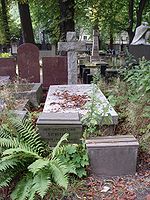
Johann Christian Schuch
Encyclopedia

Dresden
Dresden is the capital city of the Free State of Saxony in Germany. It is situated in a valley on the River Elbe, near the Czech border. The Dresden conurbation is part of the Saxon Triangle metropolitan area....
-born garden designer and architect, active in Poland
Poland
Poland , officially the Republic of Poland , is a country in Central Europe bordered by Germany to the west; the Czech Republic and Slovakia to the south; Ukraine, Belarus and Lithuania to the east; and the Baltic Sea and Kaliningrad Oblast, a Russian exclave, to the north...
.
Life

Hochschule für Bildende Künste Dresden
The Dresden Academy of Fine Arts , often abbreviated HfBK Dresden or simply HfBK, is a vocational university of visual arts located in Dresden, Germany...
, and to complete his education he traveled extensively, visiting gardens at Kew
Royal Botanic Gardens, Kew
The Royal Botanic Gardens, Kew, usually referred to as Kew Gardens, is 121 hectares of gardens and botanical glasshouses between Richmond and Kew in southwest London, England. "The Royal Botanic Gardens, Kew" and the brand name "Kew" are also used as umbrella terms for the institution that runs...
, the Grand Trianon
Grand Trianon
The Grand Trianon was built in the northwestern part of the Domain of Versailles at the request of Louis XIV, as a retreat for the King and his maîtresse en titre of the time, the marquise de Montespan, and as a place where the King and invited guests could take light meals away from the strict...
and the Schönbrunn Palace
Schönbrunn Palace
Schönbrunn Palace is a former imperial 1,441-room Rococo summer residence in Vienna, Austria. One of the most important cultural monuments in the country, since the 1960s it has been one of the major tourist attractions in Vienna...
.
In 1775 Schuch came to Poland, where he worked for Princess Izabela Lubomirska
Elżbieta Czartoryska
Elżbieta Czartoryska may refer to one of the following Polish noblewomen:*Elżbieta Czartoryska *Elżbieta Czartoryska...
and Count Michał Jerzy Mniszech. From 1781 he was superintendent of royal gardens at the Warsaw
Warsaw
Warsaw is the capital and largest city of Poland. It is located on the Vistula River, roughly from the Baltic Sea and from the Carpathian Mountains. Its population in 2010 was estimated at 1,716,855 residents with a greater metropolitan area of 2,631,902 residents, making Warsaw the 10th most...
court of King Stanisław August Poniatowski, for whom he, together with Domenico Merlini
Domenico Merlini
Domenico Merlini was an Italian-Polish architect whose work was mostly in the classical style.-Life and Style:...
and Jan Chrystian Kamsetzer, redesigned Łazienki Park. The King gave him a large estate
Folwark
Folwark is a Polish word for a primarily serfdom-based farm and agricultural enterprise , often very large. Folwarks were operated in the Crown of Poland from the 14th century and in the Grand Duchy of Lithuania since the 15th century, from the second half of the 16th century in the joint...
bordering Łazienki Park, thus securing his prosperity. There Schuch established Poland's first fruit-tree nursery
Nursery (horticulture)
A nursery is a place where plants are propagated and grown to usable size. They include retail nurseries which sell to the general public, wholesale nurseries which sell only to businesses such as other nurseries and to commercial gardeners, and private nurseries which supply the needs of...
, experimenting with novel methods of protecting the trees from excessive sun and frost, until the abnormally harsh winter of 1802–3 caused a substantial financial loss.
After the king's abdication in 1795, Schuch worked for many Polish aristocratic families
Magnate
Magnate, from the Late Latin magnas, a great man, itself from Latin magnus 'great', designates a noble or other man in a high social position, by birth, wealth or other qualities...
.
In 1811 he became a member of the Warsaw Society of Friends of Learning, before which he presented a number of papers on diverse subjects.
He married Ludwika Wolska, and they had many children. Only one son, Adolf Grzegorz, is known by name.
Schuch died in Warsaw and is buried there in the Evangelical Cemetery of the Augsburg Confession in Warsaw
Evangelical Cemetery of the Augsburg Confession in Warsaw
, The Evangelical Lutheran Cemetery of the Augsburg Confession in Warsaw is a historic Lutheran Protestant cemetery located in the Wola district, western part of Warsaw, Poland.-Details:...
.
Legacy
After his death, his name was given to Aleja Szucha (Szuch Avenue), west of the Royal Baths Park, where his estate was once located. Here, at no. 25, in 1939–45, during World War IIWorld War II
World War II, or the Second World War , was a global conflict lasting from 1939 to 1945, involving most of the world's nations—including all of the great powers—eventually forming two opposing military alliances: the Allies and the Axis...
, were the infamous headquarters of Nazi German security services for the Warsaw district. The building's basement housed a Gestapo
Gestapo
The Gestapo was the official secret police of Nazi Germany. Beginning on 20 April 1934, it was under the administration of the SS leader Heinrich Himmler in his position as Chief of German Police...
jail where Polish resistance fighters were tortured and killed. During the Warsaw Uprising
Warsaw Uprising
The Warsaw Uprising was a major World War II operation by the Polish resistance Home Army , to liberate Warsaw from Nazi Germany. The rebellion was timed to coincide with the Soviet Union's Red Army approaching the eastern suburbs of the city and the retreat of German forces...
of August – October 1944, mass executions of Poles took place here. The site is now preserved as a museum, known as the Mausoleum of Struggle and Martyrdom
Mausoleum of Struggle and Martyrdom
Mausoleum of Struggle and Martyrdom is a museum in Warsaw, Poland. It is a branch of the Museum of Independence. The museum presents the conditions in which Polish patriots and resistance fighters were jailed by Nazi Germany during World War II....
.

